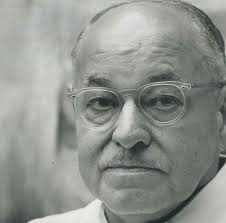group A: founders 1944
The founding members of the group were all faculty at then Carnegie Tech. The juxtaposition of these professionals exhibiting work at the Outlines Gallery, a lesser known space, and not in a conventional gallery was a catalyst for the formation of the Abstract Group in 1944. This appears to coincide with the lack of attention drawn to abstract work at the time.
Robert Lepper (1906 - 1991)
Robert Lepper is a renowned figure in the design world. He established the country’s first industrial design degree program at Carnegie Mellon University. He also produced fascinating sculptures and murals, as well as an occasional printing. As a writer, he authored a number of important theoretical works concerning both design and fine art. In 2002 the Andy Warhol Museum held the exhibit “Robert Lepper, Artist and Teacher.”
Robert Lepper continued to be a very active participant in The Abstract Group and then Group A until at least the 1970’s. His work is in various museum collections, including The Museum of Modern Art.
Russell G. twiggs (1898-1991)
Russell Gould Twiggs was an artist faculty at Carnegie Tech. Mr. Twiggs was the massier for the art department and a well-respected painter. In his role as massier, Twiggs arranged student critiques and hung exhibits. Barbara Jones, Chief Curator at the Westmoreland Museum of Art, notes that Twiggs held a top floor studio and advised students. Jones described Twiggs as the “true abstract expressionist of the group.”
Along with Samuel Rosenberg, Russell Twiggs is credited for keeping Andy Warhol from being discharged from CMU’s School of Fine Arts. Twiggs exhibited at MOMA in 1956 in the exhibit “New American Drawings”. Russell Twiggs has work in a number of museum collections including MOMA, The Whitney, The National Gallery of Art, and The Brooklyn Museum.
Samuel Rosenberg (1896-1972)
The principal founder of The Abstract Group, Samuel Rosenberg, was an extraordinarily gifted and tireless creator, teacher and innovator. He first made his mark as a painter of strong, vibrant, social realist works. While he never abandoned realism, he began experimenting with abstraction around 1940. His stunning, abstract paintings have received increasing recognition in recent years.
Rosenberg was as active as a teacher as he was a painter. During his long career he taught classes at Carnegie Tech (1924-1965), Chatham University (1937-1945), Pennsylvania Women’s College, and the YMYW Hebrew Association (1926-1964). Additionally, he was committed to teaching artists in the community, including a course for World War II veterans. His work is in numerous museum collections.
Balcomb Greene 1950
balcomb greene (1904-1991)
Balcomb Greene was a well-known figure in the New York art world. In 1942 he accepted a position as a faculty member at Carnegie Tech, teaching art history and mentoring painting students. Greene was a founder and the first chairman of The American Abstract Artists (N.Y.C. 1938-present), a group that promoted not only abstraction but the importance of American art and its equivalence to art being produced in Europe.
He was an activist and writer who promoted modernism throughout his career. His work is in numerous museum collections. (Click Here to see more at Smithsonian Museum of American Archives)



